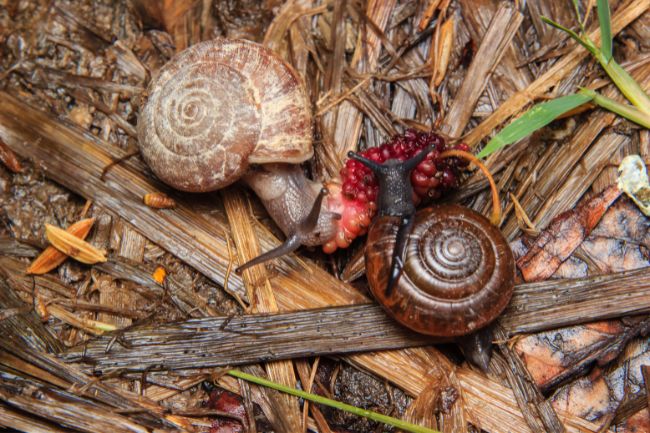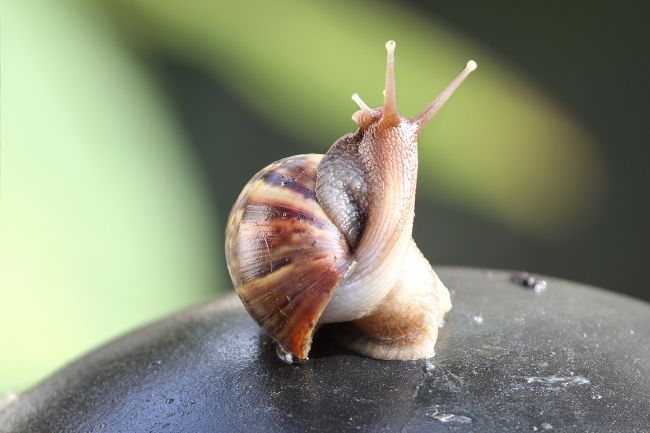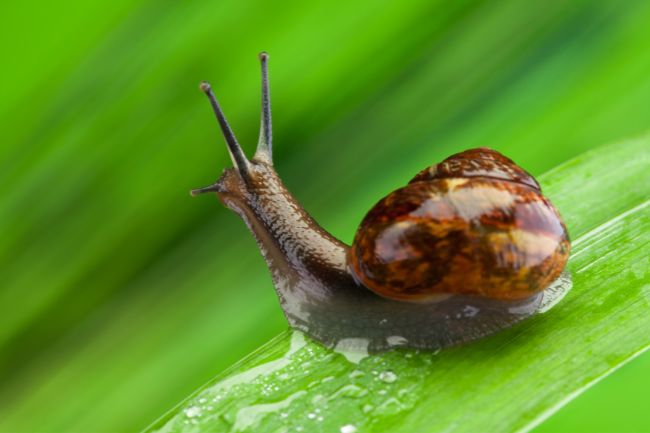Snails are slow largely because of their anatomy. They travel through a rippling movement of muscles across their one large foot. Their way is also lubricated by the mucus they produce.
Contents
Are snails slow?

As with all animal antics, it’s always important to think of them in the context of the animal’s size. A flea may not appear to be jumping very high by human standards, but for its size, it may as well be leaping over a skyscraper.
So given that snails are one of the smaller animals that live around us, can they still be considered slow?
How fast a snail moves depends in part on species, however, a good estimate is around 8cm (3.14in) per minute. Sloths are often quoted as being the slowest animals on earth, at around 1 foot (around 30.5cm or 12in) per minute, however, this is significantly faster than a snail. Yet, when we consider the size of a snail compared to a sloth, perhaps we really can’t be so hard on them.
Like sloths, one of the reasons snails are so slow is their metabolism. Both survive largely on a diet of leafy greens (though some snails have branched out to a meat-based diet), which produce a low amount of energy for the amount they require during digestion.

Marine snails that survive on a more carnivorous diet, can be significantly faster, and at times move great distances underwater. This may in part be due to the additional energy they get from their food.
There may also be an evolutionary advantage to snails keeping a steadier pace. For those that eat largely vegetation, their prey is unlikely to get away from them, so where is the rush? They are also less likely to be spotted by predators if they aren’t moving as quickly. Once they have been spotted, snails have a handy shell to retreat into, though this doesn’t always act as enough of a deterrent.
| Factor | Impact on Snail Speed |
|---|---|
| Size | Larger snails tend to move slower compared to smaller snails. |
| Environmental Conditions | Snail speed can vary based on temperature, humidity, and substrate conditions. |
| Age | Young snails may move faster than older snails. |
| Species-Specific Traits | Different snail species have varying natural speeds due to their physiological and anatomical characteristics. |
While having a shell has many advantages, there’s also a disadvantage in the additional weight a snail has to drag around with it. It may be this particular evolutionary pressure that led to some snails losing their shells, and becoming slugs.
Do snails have legs?

It probably won’t surprise you to find out snails don’t have legs. Yet, these slimy invertebrates certainly do spend a lot of their time wandering around vegetation, and over walls. So how is this possible without legs to propel them?
Instead of legs, snails have one large foot. This is the base of their body, where they are generally attached to the ground. Though it doesn’t look like the feet on the end of our own legs, it helps to move their bodies from A to B.
Table 1: Comparison of Snail Speed
| Snail Species | Average Speed (in/s) | Habitat | Description |
|---|---|---|---|
| Garden Snail | 0.0118 – 0.0197 | Gardens, parks | Garden snails are slow-moving land snails commonly found in outdoor areas. They have a typical speed of around 0.0118 to 0.0197 inches per second. |
| Roman Snail | 0.0079 – 0.0118 | Woodlands, meadows | The Roman snail, also known as the Burgundy snail, is a slow-moving land snail found in woodland and meadow habitats. It typically moves at a speed of 0.0079 to 0.0118 inches per second. |
| Giant African Snail | 0.0079 – 0.0118 | Tropical regions | The Giant African snail, as its name suggests, is a large snail species found in tropical regions. It moves at a leisurely pace of about 0.0079 to 0.0118 inches per second. |
The way a snail’s foot works is hard to see from the outside. Similar to worms, snails use muscular contractions to pull themselves across the ground. Waves of contraction and relaxation move from the tail to the head of the snail, along the central part of the foot. These waves move relatively quickly compared to the snail itself and drag the animal slowly forwards.
Also read: Earthworms Front and a Back End Explained (Difference)
What is a snail trail?
A snail trail is a line of mucus left behind by the snail as it passes over a surface. This mucus is an excretion from the snail’s foot and is important in helping it to move around.
The snail’s mucus has two seemingly contradictory properties; helping to aid movement and helping to prevent the snail from falling off. In the first instance, the snail’s mucus helps it to glide more easily across surfaces, as its muscles slowly pull it forwards. This can be particularly important over rough surfaces.
The second important property of the mucus is a glue-like quality, that helps to adhere the snail to vertical surfaces, so it can glide up walls without a worry. Interestingly, the snail also produces other kinds of mucus across the rest of its body to keep itself damp, which have a different makeup.
Also read: Snails When it Rains: Why Do They Come Out?
Why do snails leave a snail trail?

Snails leave a trail behind as they deposit their mucus as they pass. Although the majority of the mucus is water, this water evaporates quickly, leaving behind the other ingredients, which leave a shimmering path, which shows where the snail has been.
While we might not be so pleased to see these silvery trails across our walls or our lawns, today snail mucus is being praised as a beauty product. Many of the top spas now offer treatments that involve large snails crawling across the client’s skin, to try and get some of that snaily goodness.
Not so fast
When it comes to snails, it may seem at times that these tiny creatures move with amazing speed. One moment your favourite plant is thriving and happy in your garden, and the next minute it’s been munched away, down to the ground.
While it might seem like a snail has moved with lightning speed to accomplish this feat, the truth is that it was probably a gang of snails that made this happen in record time. Snails are also often active at night, meaning they appear to act quickly when they have just been working through the darkest hours.
Snails are also good at hiding, and will often eat leaves from the underside, so as to remain unseen. All of these tricks can make them appear to be tiny ninjas, when in fact they are just as slow as ever, but extra sneaky to get things done without being disturbed.

